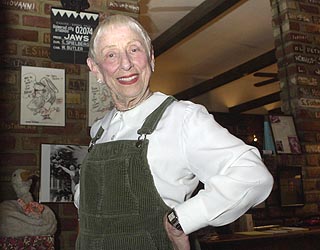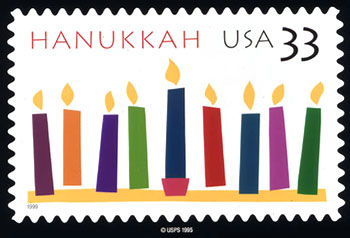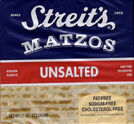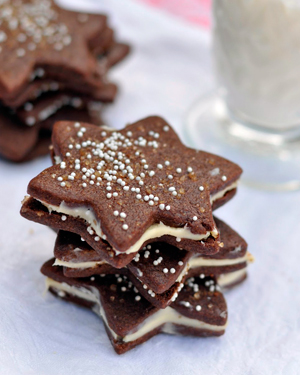 The Hanukkah crown, to be worn by the person most representing the spirit of the holiday, this year would have to go to Leah Adler, the proprietor of the Milky Way, famous for being the best upscale kosher restaurant in Beverly Hills, and because it’s owner, Leah Adler, also happens to be Steven Spielberg’s mom.
The Hanukkah crown, to be worn by the person most representing the spirit of the holiday, this year would have to go to Leah Adler, the proprietor of the Milky Way, famous for being the best upscale kosher restaurant in Beverly Hills, and because it’s owner, Leah Adler, also happens to be Steven Spielberg’s mom.
Opened over 30 years ago, the Milky Way is in its second location, neatly tucked away in the Jewish strip of Pico Blvd., and is charming and inviting from the get go. The dining room is fitted with comfy red leather booths, the tables are set with white tablecloths and oversized well-framed posters of her son’s movies hang everywhere. Looking up from a yummy cheese blintz one can see a picture of ET riding in the bicycle basket or Liam Neeson as Oskar Schindler. Even without several dozen family photos crammed on top of the bar, (in this case many with smiling celebrities and politicians) the place would feel like you were visiting your favorite Jewish aunt’s house for dinner.
One is awed by the life force of Leah Adler. She stands no more than five feet tall, if that, and at ninety-three is as alert as her radiant eyes are blue. She has worn her hair shorter than Mia Farrow’s ever was, forever. Short and still buttercup yellow, it frames the face of this beautiful leprechaun. Beaming her eyes directly into yours, she welcomes one to her restaurant the way she has for years, stopping at every booth to bestow a smile, she flashes her headlights and greets her guests.

 My friend KBell makes socks for a living. But it’s what comes out of her kitchen that’ll really knock your socks off – the world’s most perfect brisket.
My friend KBell makes socks for a living. But it’s what comes out of her kitchen that’ll really knock your socks off – the world’s most perfect brisket. Truthfully, Hanukkah makes me anxious. It’s one of those performance things. Not about making crispy incredible latkes or the homemade applesauce or the chorus of songs after the blessings. No, it’s the presents. Giving exactly the right gift meant you know exactly what the kid needs. A mom’s job, right? Um... Know who they are and you know what they want? Right? Um... Could we call it generalized mother present anxiety syndrome? Hanukah really ups the ante on the whole thing. I mean, Christmas, ok, one day. If you blow it – well, sayonara until next year, baby. But, Hanukah! Eight days! Every night! Really? I mean, who thought of that? Not the Maccabees when they decided they’d had enough of the Greeks.
Truthfully, Hanukkah makes me anxious. It’s one of those performance things. Not about making crispy incredible latkes or the homemade applesauce or the chorus of songs after the blessings. No, it’s the presents. Giving exactly the right gift meant you know exactly what the kid needs. A mom’s job, right? Um... Know who they are and you know what they want? Right? Um... Could we call it generalized mother present anxiety syndrome? Hanukah really ups the ante on the whole thing. I mean, Christmas, ok, one day. If you blow it – well, sayonara until next year, baby. But, Hanukah! Eight days! Every night! Really? I mean, who thought of that? Not the Maccabees when they decided they’d had enough of the Greeks.
 On the first night of Hanukkah, I wanted to make something representative of our holiday. On the nights that we are not entertaining friends and family for dinner, we are invited to others for food and fun.
On the first night of Hanukkah, I wanted to make something representative of our holiday. On the nights that we are not entertaining friends and family for dinner, we are invited to others for food and fun.